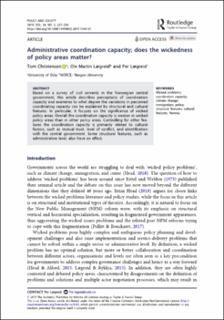| dc.contributor.author | Christensen, Tom | |
| dc.contributor.author | Lægreid, Ole Martin | |
| dc.contributor.author | Lægreid, Per | |
| dc.date.accessioned | 2020-03-30T13:40:32Z | |
| dc.date.available | 2020-03-30T13:40:32Z | |
| dc.date.created | 2019-06-29T09:34:54Z | |
| dc.date.issued | 2019 | |
| dc.identifier.citation | Policy & Society: Journal of public, foreign and global policy. 2019, 1-18. | en_US |
| dc.identifier.issn | 1449-4035 | |
| dc.identifier.uri | https://hdl.handle.net/11250/2649445 | |
| dc.description.abstract | Based on a survey of civil servants in the Norwegian central government, this article describes perceptions of coordination capacity and examines to what degree the variations in perceived coordinating capacity can be explained by structural and cultural features. In particular, it focuses on the significance of wicked policy areas. Overall the coordination capacity is weaker in wicked policy areas than in other policy areas. Controlling for other features the coordination capacity is primarily related to cultural factors, such as mutual trust, level of conflict, and identification with the central government. Some structural features, such as administrative level, also have an effect. | |
| dc.language.iso | eng | en_US |
| dc.rights | CC BY-NC 4.0 | |
| dc.rights.uri | https://creativecommons.org/licenses/by-nc/4.0/ | |
| dc.title | Administrative coordination capacity; does the wickedness of policy areas matter? | en_US |
| dc.type | Peer reviewed | en_US |
| dc.type | Journal article | en_US |
| dc.description.version | publishedVersion | |
| cristin.ispublished | true | |
| cristin.fulltext | original | |
| cristin.qualitycode | 1 | |
| dc.identifier.doi | 10.1080/14494035.2019.1584147 | |
| dc.identifier.cristin | 1708783 | |
| dc.source.journal | Policy & Society: Journal of public, foreign and global policy | en_US |
| dc.source.pagenumber | 1-18 | en_US |

